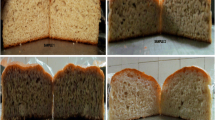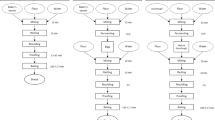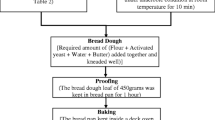Abstract
Bread is a major staple food consumed daily in all parts of the world. A significant part of the human population cannot tolerate gluten, a storage protein found in wheat, rye and barley, and therefore, products made from alternative cereals are required. During this study, the bread-making potential of seven gluten-free flours, wheat and wholemeal wheat flour was compared. Fermentation potential of the different flours was determined, showing that dough development height of gluten-free and wholemeal wheat samples was lower than for wheat and oat flour. Apart from standard bread quality parameters such as loaf-specific volume and physical crumb texture, also water activity and shelf life have been determined. The shelf life of gluten-free breads was reduced compared to wheat bread. Aroma profiles were evaluated by a trained panel. Wheat, oat and wholemeal wheat breads were liked moderately, while the remaining samples had lower liking scores. Crumb grain characteristics were investigated using image analysis, and microstructure was observed by scanning electron microscopy. Overall, only breads produced from oat flour were of similar quality to wheat bread, and the utilization of buckwheat, rice, maize, quinoa, sorghum and teff flours resulted in breads of inferior quality.





Similar content being viewed by others

References
Thompson T (2003) Oats and the gluten-free diet. J Am Diet Assoc 103(3):376–379
Rosell CM, Marco C (2008) Rice. In: Arendt EK, Dal Bello F (eds) Gluten-free cereal products and beverages. Elsevier Academic Press, Massachusetts
Gujral HS, Guardiola I, Carbonell JV, Rosell CA (2003) Effect of cyclodextrins on dough rheology and bread quality from rice flour. J Agric Food Chem 51(13):3814–3818
Nunes MHB, Ryan LAM, Arendt EK (2009) Effect of low lactose dairy powder addition on the properties of gluten-free batters and bread quality. Eur Food Res Technol 229:31–41
Moore MM, Schober TJ, Dockery P, Arendt EK (2004) Textural comparisons of gluten-free and wheat-based doughs, batters, and breads. Cereal Chem 81(5):567–575
Schober TJ, Bean SR (2008) Sorghum and maize. In: Arendt EK, Dal Bello F (eds) Gluten free cereal products and beverages. Elsevier, Burlington
Brites C, Trigo MJ, Santos C, Collar C, Rosell CM (2010) Maize-based gluten-free bread: influence of processing parameters on sensory and instrumental quality. Food Bioprocess Technol 3(5):707–715
Sanni AI, Onilude AA, Fatungase MO (1998) Production of sour maize bread using starter-cultures. World J Microbiol Biot 14(1):101–106
Flander L, Salmenkallio-Martilla M, Suortti T, Autio K (2007) Optimization of ingredients and baking process for improved wholemeal oat bread quality. LWT Food Sci Technol 40:860–870
Huettner EK, Dal Bello F, Arendt EK (2010) Fundamental study on the effect of hydrostatic pressure treatment on the bread-making performance of oat flour. Eur Food Res Technol 230(6):827–835
Rosell CM, Cortez G, Repo-Carrasco R (2009) Breadmaking use of Andean crops quinoa, Kaniwa, Kiwicha, and Tarwi. Cereal Chem 86(4):386–392
Alvarez-Jubete L, Auty M, Arendt EK, Gallagher E (2010) Baking properties and microstructure of pseudocereal flours in gluten-free bread formulations. Eur Food Res Technol 230(3):437–445
Moore MM, Juga B, Schober TJ, Arendt EK (2007) Effect of lactic acid bacteria on properties of gluten-free sourdoughs, batters, and quality and ultrastructure of gluten-free bread. Cereal Chem 84(4):357–364
Mezaize S, Chevallier S, Le Bail A, de Lamballerie M (2009) Optimization of gluten-free formulations for French-style breads. J Food Sci 74(3):E140–E146
Wrigley C, Corke H, Walker CE (2004) Encyclopedia of grain science, 2nd edn. Elsevier Academic Press, Oxford
Mohammed MIO, Mustafa AI, Osman GAM (2009) Evaluation of wheat breads supplemented with teff (Eragrostis tef (ZUCC.) Trotter) grain flour. Aust J Crop Sci 3(4):207–212
Renzetti S, Dal Bello F, Arendt EK (2008) Microstructure, fundamental rheology and baking characteristics of batters and breads from different gluten-free flours treated with a microbial transglutaminase. J Cereal Sci 48:33–45
Vallons KJR, Ryan LAM, Koehler P, Arendt EK (2010) High pressure-treated sorghum flour as a functional ingredient in the production of sorghum bread. Eur Food Res Technol 231(5):711–717
Schober TJ, Bean SR, Boyle DL (2007) Gluten-free sorghum bread improved by sourdough fermentation: biochemical, rheological, and microstructural background. J Agric Food Chem 55(13):5137–5146
Hugo LF, Rooney LW, Taylor JRN (2003) Fermented sorghum as a functional ingredient in composite breads. Cereal Chem 80(5):495–499
Hager AS, Wolter A, Jacob F, Zannini E, Arendt EK (2012) Nutritional properties and ultra-structure of commercial gluten free flours from different botanical sources compared to wheat flours. Submitt J Cereal Sci
Dal Bello F, Clarke CI, Ryan L, Ulmer H, Schober TJ, Strom K, Sjogren J, van Sinderen D, Schnurer J, Arendt EK (2007) Improvement of the quality and shelf life of wheat bread by fermentation with the antifungal strain Lactobacillus plantarum FST 1.7. J Cereal Sci 45(3):309–318
Schakel SF, Jasthi B, Van Heel N, Harnack L (2009) Adjusting a nutrient database to improve calculation of percent calories from macronutrients. J Food Comp Anal 22:S32–S36
Czerny M, Christlbauer M, Christlbauer M, Fischer A, Granvogl M, Hammer M, Hartl C, Moran-Hernandez N, Schieberle P (2008) Re-investigation on odour thresholds of key food aroma compounds and development of an aroma language based on odour qualities of defined aqueous odorant solutions. Eur Food Res Technol 228:265–273
Buttery RG, Guadagni DG, Ling LC (1976) Geosmin, a musty off-flavor of dry beans. J Agric Food Chem 24:419–420
Schuh C, Schieberle P (2006) Characterization of the key aroma compounds in the beverage prepared from Darjeeling black tea: quantitative differences between tea leaves and infusion. J Agric Food Chem 54:916–924
Seyer ME, Gelinas P (2009) Bran characteristics and wheat performance in whole wheat bread. Int J Food Sci Technol 44(4):688–693
Rosell CM, Santos E (2010) Impact of fibers on physical characteristics of fresh and staled bake off bread. J Food Eng 98(2):273–281
Cauvain SP, Whitworth MB, Alava JM (1999) The evolution of bubble structure in bread doughs and its effect on bread structure, American Association of Cereal Chemists. St. Paul, Minnesota
Scalon MG, Zghal MC (2001) Bread properties and crumb structure. Food Res Int 34:841–864
Sciarini LS, Ribotta PD, Leon AE, Perez GT (2010) Influence of gluten-free flours and their mixtures on batter properties and bread quality. Food Bioprocess Technol 3(4):577–585
Bultosa G, Hall AN, Taylor JRN (2002) Physico-chemical characterization of grain teff [Eragrostis Tef (Zucc.) Trotter] starch. Starch Staerke 54:461–468
Singh N, Singh J, Kaur L, Sodhi NS, Gill BS (2003) Morphological, thermal and rheological properties of starches from different botanical sources. Food Chem 81(2):219–231
Sluimer P (2005) Principles of breadmaking, functionality of raw materials and process steps. American association of cereal chemists. St. Paul, Minnesota
Capristo E, Addolorato G, Mingrone G, De Gaetano A, Greco AV, Tataranni PA, Gasbarrini G (2000) Changes in body composition, substrate oxidation, and resting metabolic rate in adult celiac disease patients after a 1-year gluten-free diet treatment. Am J Clin Nutr 72(1):76–81
Smecuol E, Gonzalez D, Mautalen C, Siccardi A, Cataldi M, Niveloni S, Mazure R, Vazquez H, Pedreira S, Soifer G, Boerr LA, Maurino E, Bai JC (1997) Longitudinal study on the effect of treatment on body composition and anthropometry of celiac disease patients. Am J Gastroenterol 92(4):639–643
Dickey W, Kearney N (2006) Overweight in celiac disease: prevalence, clinical characteristics, and effect of a gluten-free diet. Am J Gastroenterol 101:2356–2359
Rojas JA, Rosell CM, de Barber CB, Perez-Munuera I, Lluch MA (2000) The baking process of wheat rolls followed by cryo scanning electron microscopy. Eur Food Res Technol 212(1):57–63
Acknowledgments
The authors want to thank Eimear Gallagher, Tanja Stahn and Tom Hannon for technical support and Deborah Waters for correcting the manuscript. This study was financed by the Seventh framework Program of the European Community for research, technological development and demonstration activities (2007–2013). Specific programme “Capacities”-Research for the benefit of SMEs (262418GLUTENFREE). Funding for Anna-Sophie Hager was received through an EMBARK scholarship granted by the Irish Research Council for Science, Engineering & Technology (IRCSET). IRCSET’s initiatives are funded by the National Development Plan of Ireland under the auspices of the Department of Education & Science. This research was also partly funded by FIRM Ireland.
Author information
Authors and Affiliations
Corresponding author
Rights and permissions
About this article
Cite this article
Hager, AS., Wolter, A., Czerny, M. et al. Investigation of product quality, sensory profile and ultrastructure of breads made from a range of commercial gluten-free flours compared to their wheat counterparts. Eur Food Res Technol 235, 333–344 (2012). https://doi.org/10.1007/s00217-012-1763-2
Received:
Revised:
Accepted:
Published:
Issue Date:
DOI: https://doi.org/10.1007/s00217-012-1763-2



